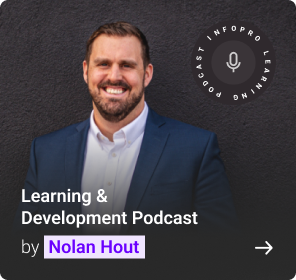Blended learning has emerged as a powerful and innovative approach to employee training and development, revolutionizing how employees learn and instructors deliver training. With technological advancements and a growing emphasis on personalized learning experiences, blended learning has gained significant traction in organizations worldwide.
This transformative training model combines traditional face-to-face instruction with online components, creating a dynamic and flexible learning environment that caters to the diverse needs of learners. As per Dataintelo’s analysis, the blended learning market is projected to reach a value of USD 6.3 million by 2030, indicating a growth rate of 9% annually.
In this blog, we will delve into the essence of blended learning, exploring its definition, models, and the myriad benefits it brings to both instructors and learners.
What is Blended Learning?
Blended learning integrates the best of both worlds, leveraging the interactive and collaborative aspects of in-person instruction while harnessing the flexibility and personalized nature of online learning. It creates a cohesive learning experience by seamlessly blending various modes of instruction, such as multimedia content, virtual discussions, self-paced modules, and hands-on activities.
This holistic approach aims to enhance learning outcomes, engage learners, and cater to different learning styles and preferences. According to Evelyn’s research report for 2023, the big things to watch out for will be a mix of online and in-person learning. Blended learning is crucial in employee training due to the following reasons:
- Enhanced Engagement: Interactive online modules and multimedia content capture employees’ attention, boosting engagement and knowledge retention.
- Flexibility and Convenience: Access to training materials at their own pace enables employees to balance training and other work responsibilities.
- Personalized Learning: Individualized assessments and tailored feedback accommodate diverse learning preferences, promoting skill development.
- Cost-Effectiveness: Reduces costs associated with travel, venue rentals, and printed materials, leading to significant savings.
- Continuous Learning: Ongoing support and resources allow employees to access information and refresh their knowledge when needed.
- Data-Driven Insights: Analytics and tracking features provide valuable data for evaluating training effectiveness and identifying areas of improvement.
6 Blended Learning Models Transforming Employee Training & Development
Here are the six most common types of blended learning models:
1. Rotation Model
The rotation blended learning model, often considered the foundation of blended learning, epitomizes the marriage of physical and virtual realms. In this model, learners rotate between traditional face-to-face instruction and online learning components, thus capitalizing on the benefits of both worlds. The schedules are predetermined yet adaptable.
Several variations of this model exist, such as the station rotation model, where learners circulate between different learning stations, each featuring a distinct activity. By embracing the rotation blended model, educators can personalize instruction, cater to diverse learning styles, and foster independent exploration while nurturing learner collaboration.
2. Flex Model
As the name suggests, the flex model gives learners flexibility and autonomy in their learning journey. Under this model, learners predominantly engage in online learning, with the physical classroom serving as a resource hub and an avenue for personalized guidance and support.
With a blend of synchronous and asynchronous activities, the flex model empowers learners to self-pace their learning, leveraging technology to access various training resources. This model encourages learners to take ownership of their training, fostering self-discipline, time management, and critical thinking skills.
3. Self-Blend Model
The self-blend model caters to learners seeking to supplement their traditional classroom experiences with online courses or modules. In this model, learners autonomously select online courses, typically outside of their regular curriculum, to complement their in-person learning.
This tailored approach enables learners to explore their passions, delve into specialized topics, or bridge knowledge gaps. The self-blend model fosters independent learning and promotes self-motivation and a growth mindset, preparing learners for a lifelong pursuit of knowledge.
According to a recent report by Gartner, learning leaders believe that a mix of in-person and online learning is the best way to be fair, useful, and productive. By carefully creating learning materials, learners can make the most of their training, which helps them learn better and achieve better results.
4. Online Driver Model
At the forefront of technology-mediated training, the online driver blended learning model places online learning at the heart of the training experience, with minimal face-to-face instruction. In this model, learners predominantly engage in virtual classrooms, accessing course materials, participating in online discussions, and collaborating with peers through digital platforms.
Instructors act as facilitators, guiding and supporting each learner’s journey remotely. The online driver blended learning model provides flexibility, accessibility, and a globalized perspective, enabling learners to transcend geographical boundaries and engage with diverse resources and perspectives.
5. Enriched Virtual Model
The enriched virtual blended learning model maintains a healthy balance between face-to-face instruction and online learning, blending the best of both physical and virtual environments. In this model, learners attend scheduled in-person classes, complemented by online components that extend and enrich their learning experience.
Online resources, assignments, and discussions deepen understanding, while in-person sessions offer opportunities for active collaboration, hands-on activities, and direct interaction with instructors or trainers. The enriched virtual model nurtures community, engagement, and holistic learning.
6. Flipped Model
The flipped classroom blended learning model, an innovative approach in corporate training, revolutionizes the traditional classroom experience. This model provides learners with pre-recorded lectures or online modules to explore foundational concepts at their own pace. Subsequently, face-to-face sessions are dedicated to interactive discussions, collaborative projects, and problem-solving activities.
By flipping the traditional learning process, this model empowers employees to engage in knowledge application actively and fosters deeper comprehension through meaningful interactions. The flipped classroom blended learning model promotes self-directed learning while capitalizing on the benefits of in-person engagement, resulting in enhanced employee engagement, knowledge retention, and skill development.
Since each organization has different needs and resources, we can’t say that one blended learning model is better than another. It’s the responsibility of the L&D teams to use their knowledge, LMS data, and feedback from learners to pick a learning model that suits the organization’s training goals without putting too much pressure on trainers.
Conclusion
Blended learning combines in-person and online training to improve employee learning. It offers many benefits like increased engagement, flexibility, personalized learning, cost savings, continuous learning, and the ability to use data for insights. Using blended learning in corporate training can make it more effective and affordable.
Blended learning models also give employees more control over their learning, allowing them to choose when and how they learn and develop their skills. This blog explores six common blended learning models: rotation, flex, self-blend, online driver, enriched virtual, and flipped models. These models provide trainers and learners with options to optimize their training experiences.





